Using record linkage to validate notification and laboratory data for a more accurate assessment of notifiable infectious diseases
- PMID: 28623916
- PMCID: PMC5473994
- DOI: 10.1186/s12911-017-0484-7
Using record linkage to validate notification and laboratory data for a more accurate assessment of notifiable infectious diseases
Abstract
Background: Infectious disease burden is commonly assessed using notification data. Using retrospective record linkage in Western Australia, we described how well notification data captures laboratory detections of influenza, pertussis and invasive pneumococcal disease (IPD).
Methods: We linked data from the Western Australian Notifiable Infectious Diseases Database (WANIDD) and the PathWest Laboratory Database (PathWest) pertaining to the Triple I birth cohort, born in Western Australia in 1996-2012. These were combined to calculate the number of unique cases captured in each dataset alone or in both datasets. To assess the impact of under-ascertainment, we compared incidence rates calculated using WANIDD data alone and using combined data.
Results: Overall, there were 5550 influenza, 513 IPD (2001-2012) and 4434 pertussis cases (2000-2012). Approximately 2% of pertussis and IPD cases and 7% of influenza cases were solely recorded in PathWest. Notification of influenza and pertussis cases to WANIDD improved over time. Overall incidence rates of influenza in children aged <5 years using both datasets was 10% higher than using WANIDD data alone (IRR = 1.1, 95% CI = 1.1-1.2).
Conclusions: This is the first time WANIDD data have been validated against routinely collected laboratory data. We anticipated all cases would be captured in WANIDD but found additional laboratory-confirmed cases that were not notified. Studies investigating pathogen-specific infectious disease would benefit from using multiple data sources.
Keywords: Disease notification; Record linkage; Validation studies.
Figures
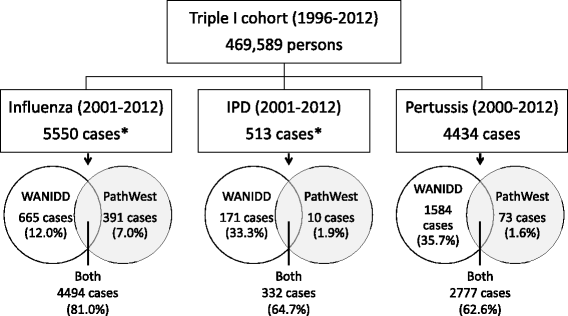
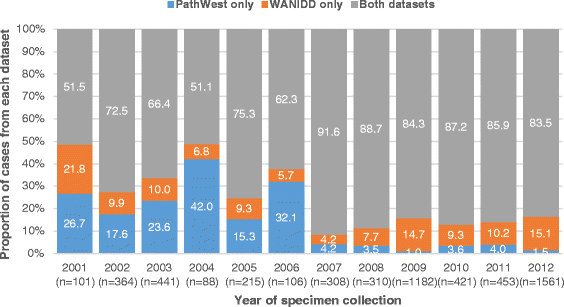
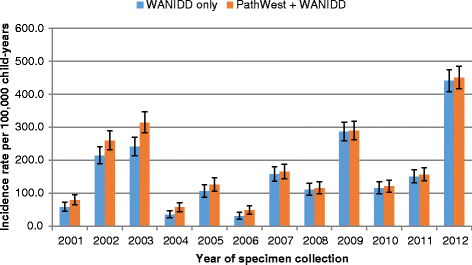
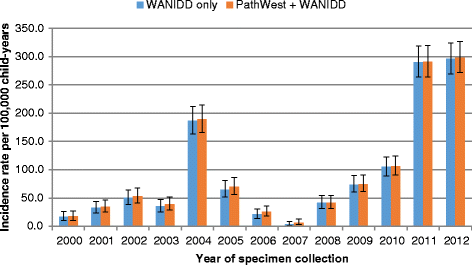
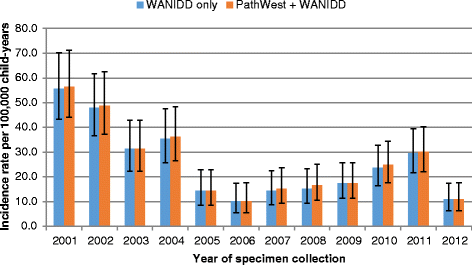
Similar articles
-
The contribution of PCR testing to influenza and pertussis notifications in Australia.Epidemiol Infect. 2016 Jan;144(2):306-14. doi: 10.1017/S0950268815001004. Epub 2015 Jun 26. Epidemiol Infect. 2016. PMID: 26112983
-
Influenza surveillance in Australia: we need to do more than count.Med J Aust. 2010 Jul 5;193(1):43-5. doi: 10.5694/j.1326-5377.2010.tb03741.x. Med J Aust. 2010. PMID: 20618114
-
Improving the accuracy of Aboriginal and non-Aboriginal disease notification rates using data linkage.BMC Health Serv Res. 2008 May 30;8:118. doi: 10.1186/1472-6963-8-118. BMC Health Serv Res. 2008. PMID: 18510777 Free PMC article.
-
An overview of the epidemiology of notifiable infectious diseases in Australia, 1991-2011.Epidemiol Infect. 2016 Nov;144(15):3263-3277. doi: 10.1017/S0950268816001072. Epub 2016 Jun 22. Epidemiol Infect. 2016. PMID: 27586156 Free PMC article. Review.
-
Defining pertussis epidemiology: clinical, microbiologic and serologic perspectives.Pediatr Infect Dis J. 2005 May;24(5 Suppl):S25-34. doi: 10.1097/01.inf.0000160926.89577.3b. Pediatr Infect Dis J. 2005. PMID: 15876920 Review.
Cited by
-
Elevated CD3low double negative T lymphocyte is associated with pneumonia and its severity in pediatric patients.PeerJ. 2018 Dec 18;6:e6114. doi: 10.7717/peerj.6114. eCollection 2018. PeerJ. 2018. PMID: 30588404 Free PMC article.
-
Usefulness of linked data for infectious disease events: a systematic review.Epidemiol Infect. 2023 Feb 27;151:e46. doi: 10.1017/S0950268823000316. Epidemiol Infect. 2023. PMID: 36843485 Free PMC article.
-
Linking administrative data sets of inpatient infectious diseases diagnoses in far North Queensland: a cohort profile.BMJ Open. 2020 Mar 18;10(3):e034845. doi: 10.1136/bmjopen-2019-034845. BMJ Open. 2020. PMID: 32193270 Free PMC article.
-
Invasive group B streptococcal infections in Western Australia, 2000-2018.Intern Med J. 2025 Mar;55(3):453-460. doi: 10.1111/imj.16611. Epub 2025 Jan 8. Intern Med J. 2025. PMID: 39780516 Free PMC article.
References
-
- Department of Health. Protocol for making a change to the National Notifiable Diseases List (NNDL) in Australia [Internet]. [cited 2016 Jun 20]. Available from: http://www.health.gov.au/internet/main/publishing.nsf/Content/ohp-protoc....
-
- Department of Health. Surveillance systems reported in Communicable Diseases Intelligence, 2016 [Internet]. [cited 2016 Jun 20]. Available from: http://www.health.gov.au/internet/main/publishing.nsf/Content/cda-survei....
Publication types
MeSH terms
LinkOut - more resources
Full Text Sources
Other Literature Sources
Medical

